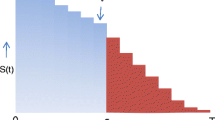Abstract
While the utility value of life may decrease monotonically with age, the dollar value may increase dramatically until a fairly old age (by ten-fold to age 60 for one plausible set of parameters). Crucial for this result is a high enough real rate of interest (e.g. 4–5%) which makes accumulation desirable, leading to a lower marginal utility of money when one gets older, explaining the divergence. This divergence raises perplexing questions as to which value of life should be used and whether the old should be taxed and the young subsidized.
Similar content being viewed by others
References
Arthur, W. B. (1981): “The Economics of Risk to Life.”American Economic Review 71: 54–64.
Berger, M. C., Blomquist, G. C., Kenkel, D., and Tolley, G. S. (1986): “Valuing Changes in Health Risks: A Comparison of Alternative Measures.”Southern Economic Journal 53: 967–984.
Bergstrom, T. C. (1982): “When Is a Man's Life Worth More than His Human Capital?” InThe Value of Life and Safety, edited by M. W. Jones-Lee. Amsterdam: North-Holland.
Diamond, P. (1965): “National Debt in a Neoclassical Growth Model.”American Economic Review 55: 1126–1150.
Harrington, W., and Portney, P. R. (1987): “Valuing the Benefits of Health and Safety Regulation.”Journal of Urban Economics 22: 101–112.
Ihori, T. (1978): “The Golden Rule and the Role of Government in a Life Cycle Growth Model.”American Economic Review 68: 389–396.
Ippolito, P. M., and Ippolito, R. A. (1984): “Measuring the Value of Life Saving from Consumer Reactions to New Information.”Journal of Public Economics 25: 53–81.
Jones-Lee, M. W. (1976):The Value of Life. London: Martin Robertson.
— (Ed.) (1982):The Value of Life and Safety. Amsterdam: North-Holland.
Jones-Lee, M. W., Hammerton, M., and Philips, P. R. (1985): “The Value of Safety: Results of a National Sample Survey.”Economic Journal 95: 49–72.
Mishan, E. J. (1971): “The Valuation of Life and Limb: A Theoretical Approach.”Journal of Political Economy 79: 687–705.
Nerlove, M., Razin, A., and Sadka, E. (1987):Household and Economy: Welfare Economics of Endogenous Fertility. Boston: Academic Press.
Ng, Y.-K. (1979/1983):Welfare Economics. London: Macmillan.
— (1984): “Quasi-Pareto Social Improvements.”American Economic Review 74: 1033–1050.
— (1988) “Economic Efficiency versus Egalitarian Rights.”Kyklos 41: 215–237.
Ng, Y.-K. (1989): “Divergence Between Utility and Dollar Values of Life as One Ages: Solving the Parish Paradox and Raising Perplexing Policy Issues.” Monash Seminar Paper 5/1989, Monash University; also presented at the First International Conference on Social Choice and Welfare at Valencia, Spain, July 1989.
Ng, Y.-K. (forthcoming): “The Paradox of the Adventurous Young and the Cautious Old: Natural Selection versus Rational Calculation.”Journal of Theoretical Biology.
Schelling, T. C. (1968): “The Life You Save May Be Your Own.” InProblems in Public Expenditure Analysis, edited by S. B. Chase. Washington, D.C.: Brookings.
Seidl, C. (1988): “Experimental Utility Functions of Income and Their Associated Tax Schedules.” Discussion Paper No. 22, Institut für Finanzwissenschaft, University of Kiel.
Shepard, D. S., and Zeckhauser, R. J. (1982): “Life-cycle Consumption and Willingness to Pay for Increased Survival.” InThe Value of Life and Safety, edited by M.W. Jones-Lee. Amsterdam: North-Holland.
Stein, J. L. (1969): “A Minimal Role of Government in Achieving Optimal Growth.”Economica 36: 139–150.
Willis, R. J. (1987): “Externalities and Population.” InPopulation Growth and Economic Development: Issues and Evidence, edited by D. G. Johnson and R. D. Lee. Madison, WI: University of Wisconsin Press.
Author information
Authors and Affiliations
Additional information
I am grateful to Ross Parish for stimulation and to Keith McLaren and an anonymous referee for helpful comments.
Rights and permissions
About this article
Cite this article
Ng, YK. The older the more valuable: Divergence between utility and dollar values of life as one ages. Zeitschr. f. Nationalökonomie 55, 1–16 (1992). https://doi.org/10.1007/BF01236005
Received:
Revised:
Issue Date:
DOI: https://doi.org/10.1007/BF01236005




